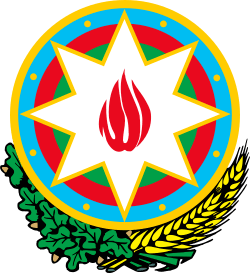Christianity in Azerbaijan
| Part of a series on |
| Azerbaijanis |
|---|
| Culture |
| Traditional areas of settlement |
| Diaspora |
| Religion |
| Language |
| Persecution |
|
Christianity in Azerbaijan is a minority religion. Christians who estimated between 280,000-450,000 (3.1%-4.8%)[1] are mostly Russian and Georgian Orthodox and Armenian Apostolic (almost all Armenians live in the break-away unrecognized Republic of Nagorno-Karabakh). There is also a small Protestant Christian community most of them came from Muslim backgrounds.[2][3]
History
Christianity spread to territory of Azerbaijan in the first years of the new era. The first stage of this period is called the period of Apostles Bartholomew and Thaddeus (same ones who Christianized Armenia), who spread the new religion by the benediction of the first patriarch of Jerusalem Yegub. The first church was erected in the village Kish. This church was constructed before the first Armenian Christian church.
Eastern Orthodoxy
Adherents of Eastern Orthodox Christianity in Azerbaijan are mainly ethnic Russians and Georgians. Russan Orthodox communities belong to the Russian Orthodox Church in Azerbaijan. Entire territory of Azerbaijan is under ecclesiastical jurisdiction of the Russian Orthodox Eparchy of Baku and Azerbaijan, centered in the Holy Myrrhbearers Cathedral in Baku.[4]
Oriental Orthodoxy
Adherents of Oriental Orthodox Christianity in Azerbaijan are mainly ethnic Armenians. The Armenian Apostolic Church currently has no community outside the Nagorno-Karabakh Republic. Before the outbreak of the war, Armenians formed the largest Christian population in the country. Today, Armenian churches in Azerbaijan remain closed, because of the large outmigration of Armenians and fear of Azerbaijani attacks.[5] During the Nagorno-Karabakh War, despite the constitutional guarantees against religious discrimination, numerous acts of vandalism against the Armenian Apostolic Church have been reported throughout Azerbaijan.[6] At the height of the Baku pogrom in 1990, the Armenian Church of St. Gregory Illuminator in was set on fire,[7] but was restored in 2004 and is not used anymore.
Other denominations
There is only one congregation in the Catholic Church in Azerbaijan: a church in Baku was opened in 2007.
There are eleven Molokan communities. The Molokans are a Christian minority which, much like Protestants in Western Europe, center their beliefs on the Bible and reject church hierarchy. 2.5% of the population belong to the Russian Orthodox Church (1998). The Russian Orthodox Church in Azerbaijan has the Eparchy of Baku and the Caspian region with a seat in Azerbaijan. Among the famous landmark Russian churches are Church of Michael Archangel, Holy Myrrhbearers Cathedral and Alexander Nevsky Cathedral destroyed by the communists at the beginning of the 20th century.
The Albanian-Udi Church is of the Udi people minority in Azerbaijan.
There is a German Lutheran community, likely to number less than 7,000 Protestants. There is also a Georgian Orthodox community and churches.
See also
Notes
- ↑ Global Christianity An Interactive Feature
- ↑ "5,000 Azerbaijanis adopted Christianity" (in Russian). Day.az. 7 July 2007. Retrieved 30 January 2012.
- ↑ "Christian Missionaries Becoming Active in Azerbaijan" (in Azerbaijani). Tehran Radio. 19 June 2011. Retrieved 12 August 2012.
- ↑ Православие в Азербайджане / Православие.Ru Archived October 19, 2013, at the Wayback Machine.
- ↑ United States Department of State, Country Reports on Human Rights Practices for 1992 (Washington: U.S. Government Printing Office, February 1993), p. 708
- ↑ Memorandum from the Lawyers Committee for Human Rights to John D. Evans, Resource Information Center, 13 June 1993, p. 4.
- ↑ Implementation of the Helsinki Accords: Human Rights and Democratization in the Newly Independent States of the former Soviet Union" (Washington, DC: U.S. Congress, Commission on Security and Cooperation in Europe, January 1993), p. 116
Further reading
- Adherents.com - Religion by Location: Azerbaijan
- Fahlbusch, Erwin, ed. (1999), "Azerbaijan", Encyclopedia of Christianity, 1, Grand Rapids: Wm. B. Eerdmans, pp. 175–176, ISBN 0802824137

